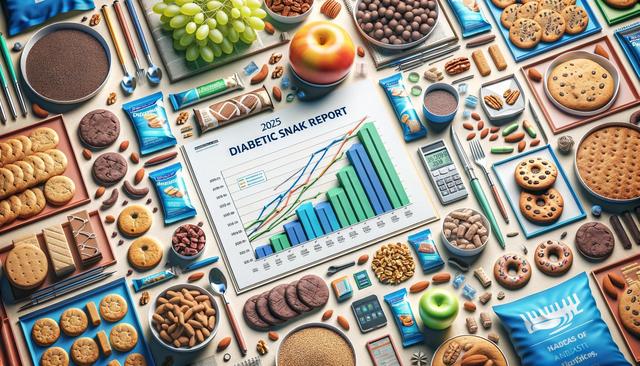2025 Diabetic Snack Industry Report: From Formulas to Consumer Trends
2025 sees a boom in the diabetic snack market. This article analyzes consumer demands (low – sugar, convenience, taste), brand innovations (functional snacks on the rise), and supply chain advancements (sugar – free ingredient tech). It offers insights for industry players and patients, revealing how to balance health and commerce to create the next “must – have” diabetic snack.

Understanding the Rise in Consumer Demand
The diabetic snack market is undergoing a significant transformation in 2025, spurred by growing consumer awareness and changing dietary needs. Individuals managing diabetes are increasingly seeking snack options that align with their health goals while still offering convenience and enjoyable flavors. As a result, consumer preferences for diabetic snacks 2025 are shaping a new standard in product development. Shoppers are prioritizing:
- Low-sugar or sugar-free formulations
- Portability for on-the-go lifestyles
- Natural, recognizable ingredients
- Appealing taste without compromising health
This shift in expectations is driving the need for innovation in both formulation and packaging. Brands that can balance taste and nutrition are more likely to capture this growing segment of health-conscious consumers. According to recent data, the diabetic snack market size 2025 US is projected to expand significantly, reflecting the increasing purchasing power and active engagement of this demographic.
Brand Innovation and Functional Snack Development
In response to consumer needs, snack developers are turning toward functional ingredients and enhanced nutritional profiles. The emergence of snacks that provide more than just sustenance—offering benefits like blood sugar support, fiber enrichment, and satiety—is reshaping how products are positioned in the market. This movement toward functionality is central to diabetic snack brand growth strategies 2025.
Functional diabetic snacks now incorporate elements like:
- Protein from plant-based sources
- Slow-digesting carbohydrates for stable glucose levels
- Fiber blends that promote digestive health
- Superfoods with antioxidant properties
Brands are also rethinking traditional flavor profiles to align with evolving tastes. Savory options, spicy infusions, and international flavor inspirations are becoming more common, helping diabetic snacks move beyond the stereotype of bland health food. This innovation is positioning diabetic snacks as an appealing choice for a wider audience, not just those managing blood sugar levels.
Advancements in Sugar-Free Ingredient Technologies
One of the most pivotal developments in the industry is the advancement of sugar – free ingredient trends in diabetic snacks. Ingredient manufacturers are leveraging food science to create sweeteners and carbohydrate alternatives that do not spike blood sugar levels, while still delivering the sensory experience consumers expect from snacks.
Some of the standout ingredient innovations include:
- Natural sweeteners like allulose and monk fruit
- Resistant starches and prebiotic fibers
- Low-glycemic flours made from legumes or nuts
- Flavor enhancers that reduce the need for added sugars
These ingredients are not only helping brands comply with health guidelines but also enabling them to create products that meet the taste expectations of modern consumers. The integration of these technologies is a cornerstone of product differentiation and is expected to play a key role in the expanding diabetic snack market size 2025 US.
Supply Chain Adaptation and Market Accessibility
As demand grows, supply chains are adapting to accommodate the specialized needs of the diabetic snack segment. Sourcing clean, low-glycemic ingredients and ensuring their consistency at scale requires coordination across production, distribution, and retail. Forward-thinking brands are investing in transparent sourcing, ethical production, and clear labeling to build consumer trust.
Retailers are also responding by allocating more shelf space to diabetic-friendly products and expanding their offerings online. Direct-to-consumer (DTC) channels are especially effective for niche products, allowing companies to tailor messaging and gather valuable data on consumer preferences for diabetic snacks 2025. To remain competitive, brands are implementing:
- Integrated supply chain technologies for quality control
- Real-time inventory systems to meet demand surges
- Flexible packaging options for different consumption needs
- Eco-conscious practices that appeal to values-led consumers
These operational adjustments are helping brands meet rising expectations while maintaining the agility needed to innovate and scale quickly in a dynamic market environment.
Balancing Health and Commercial Success
Success in the diabetic snack industry is increasingly tied to a brand’s ability to marry nutritional integrity with compelling consumer experiences. This requires a delicate balance between health-focused innovation and commercial viability. Brands must navigate complex regulatory requirements, invest in research and development, and communicate effectively with an informed consumer base.
Emerging diabetic snack brand growth strategies 2025 include collaborations with nutritionists, digital campaigns targeted at diabetic communities, and educational content that demystifies low-glycemic diets. These efforts not only build credibility but also empower consumers to make smarter choices. As competition increases, differentiation through storytelling, ingredient transparency, and functional benefits will likely become key drivers of brand loyalty.
Ultimately, the brands that listen to their audience and continuously adapt—while staying grounded in science and ethics—are the ones that will thrive in this rapidly evolving space. With continued progress in sugar – free ingredient trends in diabetic snacks and a deeper understanding of consumer preferences for diabetic snacks 2025, the industry has the tools to meet both health needs and market demand.
Conclusion: Opportunities for Stakeholders in the Diabetic Snack Space
The diabetic snack industry in 2025 presents a unique intersection of healthcare, food innovation, and consumer lifestyle. For manufacturers, retailers, and health professionals, understanding the expanding diabetic snack market size 2025 US is crucial to identifying opportunities and anticipating challenges. By focusing on quality ingredients, functional benefits, and evolving tastes, brands can create products that support health without sacrificing enjoyment.
At the same time, individuals managing diabetes now have access to a wider range of convenient and satisfying snack options that align with their dietary goals. As the market continues to grow, collaboration across sectors—food technology, nutrition, retail, and supply chain management—will be key to sustaining innovation and maintaining trust. With the right approach, the diabetic snack space can continue to thrive as a model of how health-focused products can be both impactful and commercially successful.